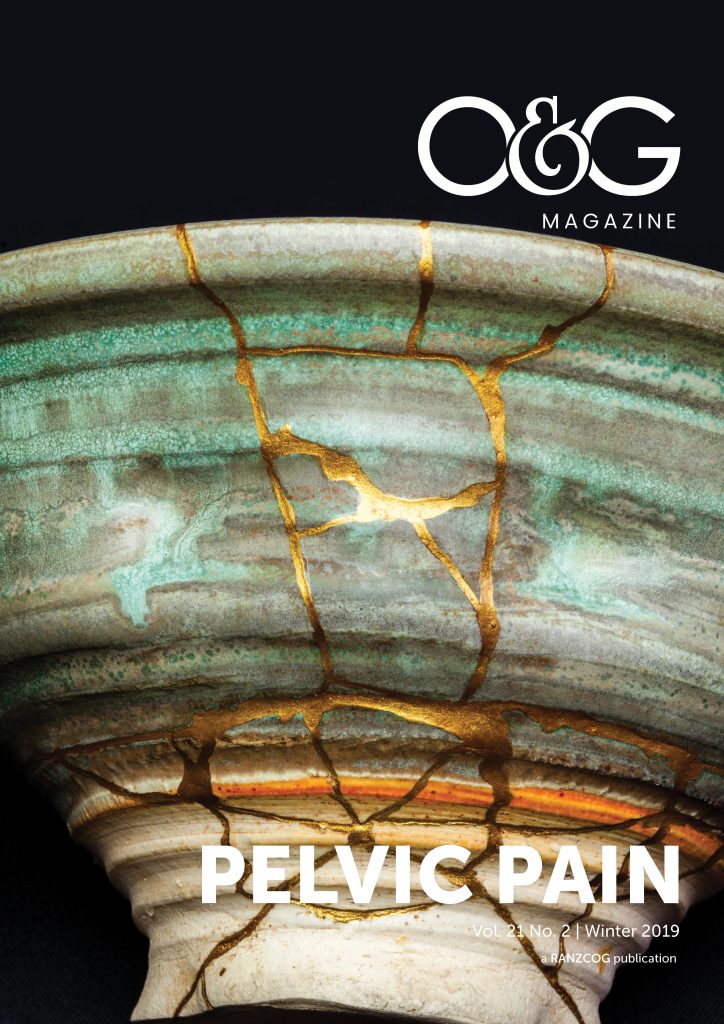Chronic pelvic pain (CPP) is a common presentation to GPs and gynaecologists. Effective management of CPP, however, is often found to be challenging. A 2018 survey1 of UK gynaecologists found that 45 per cent felt they were unable to adequately manage CPP, and a 2016 audit of gynaecologists at a tertiary women’s hospital in NZ found that only 7 per cent rated the quality of their CPP assessment as ‘good’ and none as ‘excellent’.2
The ICD-11 defines chronic pain as ‘Pain that persists or recurs for more than three months’ and, unlike acute pain, represents a distinct disease state in itself. An accumulating body of evidence demonstrates that CPP shares the same mechanisms and comorbidities of other chronic pain syndromes.3 4 5
Lesion-focused management
In practice, persistent pelvic pain is often not recognised as a distinct diagnosis; with clinical focus remaining entirely on attempting to locate and remediate an assumed end-organ pathology. This lesion-focused approach is at odds with the well-recognised multidisciplinary approaches recommended for other persistent pain conditions. This means that the mainstay of management of pelvic pain remains heavily biomedical and end-organ focused. This approach neglects the influence of the surrounding structures and wider nervous system inputs on pain, as well as the wider pain-related symptoms and distress that women living with pelvic pain experience.6 7
There is also often a mistaken belief that persisting pelvic pain is always a sign of, or directly synonymous with, endometriosis; thus, surgical investigation and intervention are imperative. This is a view that is unfortunately strongly advocated for within many media forums. It is consistently reported in the literature, however, that there is no good correlation between stage or laterality of lesions and symptoms experienced, and over a third of laparoscopies performed for this indication find no pathology.8 9
Women with persisting pelvic pain report a wide range of extra-pelvic pain syndromes, such as migraine, irritable bowel syndrome and widespread musculoskeletal or myofascial pain syndromes.10 11 A focus centred on the presence of visible lesions risks ignoring these, and other, comorbid difficulties that are frequently experienced alongside chronic pain, such as anxiety and depression, chronic fatigue, neurocognitive changes, and the associated impacts on social relationships, work and productivity.
This lesion-focused approach can also creates a false dichotomy; implying that normal investigations suggest pain is somehow the fault of the patient, or imagined; when it has been shown that those with pelvic pain and no demonstrable lesions share the same characteristics12 13 and central changes as those with them.14 15 This risks leaving the patient feeling there are no treatment options for their pain and unnecessarily exacerbates distress.
Current management of pelvic pain usually comprises of hormonal manipulation or surgical procedures. Neither of these approaches has been shown to be superior to the other,16 17 18 nor to bring long-term improvement. Medical therapy has been shown to improve quality of life in up to two thirds of women; however, it requires long-term use and can bring significant side effects. Surgery often results in only partial or temporary pain relief, with one-in-five experiencing no improvement and about half of patients who do benefit experiencing symptom recurrence by two-year follow up.19 20
It is increasingly recognised that repeated laparoscopic procedures are neither successful nor appropriate management for pelvic pain.21 22 However, data from health insurer Southern Cross NZ places surgery for endometriosis within the top five across all surgeries for women between the ages of 21–50. A 2014 patient poll by Endometriosis NZ also demonstrated the large number of these procedures being undertaken, reporting a mean number of four surgeries per respondent, with a range from 1–25. Despite this, 70 per cent of respondents who had undergone surgery reported no improvement in pain.
The benefits of multidisciplinary team management
Recommended treatments for persistent pain, in comparison, include biomedical approaches as just one component in management. This allows for all inputs driving ongoing pain to be addressed; a multifactorial approach that optimises outcomes for women living with pelvic pain.
The benefits of multidisciplinary team (MDT) management for people living with persisting pain has been recognised for over four decades,23 24 with the supporting evidence base continuing to grow as knowledge about pain neurobiology increases.
The adoption of this model to pelvic pain has, however, been lagging; despite mounting evidence that CPP shares the same mechanisms and comorbidities of other chronic pain syndromes,25 26 27 and over 30 years of evidence that multimodal MDT approaches to CPP demonstrate superiority over solely biomedical ones in quality-of-life outcomes, cost-effectiveness, iatrogenic risk and reducing future surgeries and emergency department visits. 28 29 30 31
Symptom-focused approaches: treating the whole person
Unlike unimodal approaches for CPP, pain specialist MDTs have expertise both in scope of practice and specialist pain knowledge in order to address the multifactorial contributors of pain and associated comorbidities.
MDT approaches are multi-pronged, to address both bottom-up and top-down contributors to ongoing pain. While the scopes of team members may vary depending on the needs of an individual patient, professions involved typically include: pain specialist doctors, physiotherapists, psychologists, occupational therapists, specialist nurses and social workers; all with specialist understanding of pain management. For pelvic pain, in particular, pelvic floor physiotherapists and therapists with training in sexual disorders are also included.
For all professionals working in pain, it is not sufficient to simply hold a qualification in their scope. Just as different areas of medicine require some specialism, appropriate education, experience and supervision pertaining to pain is essential to ensure that unhelpful messages about pain are not being inadvertently reinforced by practitioners who are not adequately schooled in the complexities and subtleties of this disease.
All in their heads?
Pain is by IASP definition ‘a sensory and emotional experience’. The significant contribution of psychosocial elements to the development and maintenance of persistent pelvic pain is well recognised in the literature as an important target for treatment to improve outcomes, though largely ignored within clinical practice. The Australasian Faculty of Pain Medicine recognises this key element to managing pain and has reconceptualised the required approach to a sociopsychobiomedical one.
Many patients are initially wary of the involvement of psychology or psychosocial elements of pain management, as this suggests to them that practitioners believe the pain that they experience is in some way imaginary or psychological. Unfortunately, this also seems to be the belief of many other health practitioners who see the role of psychologists within pain management as one of simply support or distress tolerance, or there to intervene with ‘histrionic’ or ‘psychosomatic’ patients. Education about the place of psychosocial elements within pain management is therefore a vital part of engaging patients in treatment, as well as helping them to use all the specialities that can improve their experience where these are available to them.
Common themes of MDT approaches include education about pain and how pain works and what happens in the pain system when pain becomes persistent. Pain management promotes active and adaptive approaches that provide experiential exposure to feared and painful activity in a safe and supported way. These programs aim to reduce fear-avoidance, increase activity tolerances, redress functional losses, increase pain-self efficacy, improve quality of life, and, for some patients, decrease or even eliminate pain.
Role of the doctor within an MDT
The medical specialist working within a chronic pain MDT has many roles, as identified in the CanMEDS framework. Specialist pain medicine physicians work to understand the current and previous pain history, review and collate patient history, balancing the need to rule out ‘red flag conditions’ with iatrogenic harms from over investigation, and act as a health educator and advocate for both patients and other MDT members.
Unfortunately, there is a paucity of specialised MDT pelvic pain centres, so all gynaecologists who work with women with pelvic pain need to develop the above skills, rather than acting solely as a ‘surgical technician’, and then engaging in endless ‘speciality ping-pong’ referrals to other end-organ specialists when a laparoscopy is normal or fails to resolve symptoms. A 2016 audit found that the majority of the surveyed gynaecologists felt their ability to explore underlying non-gynaecological and psychosocial contributors to pain was poor,32 indicating a need for greater attention to this during medical training.
There is often some reluctance to accept both self-management and MDT approaches from both the general public and some clinicians, so even when MDT pain clinics are available, there is a need for the MDT approach to be supported and validated within gynaecology clinics and by the wider gynaecological speciality so that patients receive a consistent message and are supported to see that there are alternatives or adjuncts to biomedical therapies that have fewer side effects and may have greater long-term benefits for wellbeing and quality of life.33 34 35 This also prevents dependence on passive service provision and helplessness to manage pain and pain-related distress during times of symptom flare ups.
Shifting focus from the pelvis to the person who lives with pain
Current management of pain perceived within the pelvis focuses on locating and removing lesions in the hopes of eliminating pain, even though the relationship between lesions and symptoms is poorly correlated and this approach often unsuccessful.
CPP needs to be recognised as a distinct disease state that has a specific treatment framework that focuses on all contributors and symptoms.
As growing evidence base attests, an MDT approach for persistent pain conditions offers the greatest chance for best outcomes, and as with other conditions, clinical outcomes are better where evidence-based guidelines are followed. Further education, investment and systemic change will be required before women living with pelvic pain are able to access the services they deserve.
References
- HW Leow, W Szubert, AW Horne. 45% of UK gynaecologists think chronic pelvic pain is managed badly. European Journal of Obstetrics and Gynecology and Reproductive Biology. 2018;224:200-2.
- K Joseph. Unmet healthcare-needs audit of attendees with chronic pelvic pain at the Christchurch Women’s Hospital Outpatient Clinic. 2016. Unpublished data.
- J Brawn, M Morotti, KT Zondervan, et al. Central changes associated with chronic pelvic pain and endometriosis. Hum Reprod Update. 2014;20(5):737-47.
- S As-Sanie, RE Harris, V Napadow, et al. Changes in regional gray matter volume in women with chronic pelvic pain: a voxel-based morphometry study. Pain. 2012;153(5):1006-14.
- S As-Sanie, R Black, LC Giudice, et al. Assessing research gaps and unmet needs in endometriosis. American Journal of Obstetrics and Gynecology. pii: S0002-9378(19)30385-0.
- S As-Sanie, R Black, LC Giudice, et al. Assessing research gaps and unmet needs in endometriosis. American Journal of Obstetrics and Gynecology. pii: S0002-9378(19)30385-0.
- A Yunker, NA Sathe, WS Reynolds, et al. Systematic review of therapies for noncyclic chronic pelvic pain in women. Obstetrical & Gynecological Survey. 2012;67(7):417-25.
- P Vercellini, PG Crosignani, A Abbiati, et al. The effect of surgery for symptomatic endometriosis: the other side of the story. Hum Reprod Update. 2009;15(2):177-88.
- P Vercellini, F Facchin, L Buggio, et al. Management of endometriosis: toward value-based, cost-effective, affordable care. Journal of Obstetrics and Gynaecology Canada. 2018;40(6):726-49.
- A Yunker, NA Sathe, WS Reynolds, et al. Systematic review of therapies for noncyclic chronic pelvic pain in women. Obstetrical & Gynecological Survey. 2012;67(7):417-25.
- SF Evans, TA Brooks, AJ Esterman, et al. The comorbidities of dysmenorrhea: a clinical survey comparing symptom profile in women with and without endometriosis. Journal of Pain Research. 2018;11:3181.
- SF Evans, TA Brooks, AJ Esterman, et al. The comorbidities of dysmenorrhea: a clinical survey comparing symptom profile in women with and without endometriosis. Journal of Pain Research. 2018;11:3181.
- H Grundström, B Gerdle, S Alehagen, et al. Reduced pain thresholds and signs of sensitization in women with persistent pelvic pain and suspected endometriosis. Acta Obstetricia et Gynecologica Scandinavica. 2019;98(3):327-36.
- J Brawn, M Morotti, KT Zondervan, et al. Central changes associated with chronic pelvic pain and endometriosis. Hum Reprod Update. 2014;20(5):737-47.
- S As-Sanie, RE Harris, V Napadow, et al. Changes in regional gray matter volume in women with chronic pelvic pain: a voxel-based morphometry study. Pain. 2012;153(5):1006-14.
- A Yunker, NA Sathe, WS Reynolds, et al. Systematic review of therapies for noncyclic chronic pelvic pain in women. Obstetrical & Gynecological Survey. 2012;67(7):417-25.
- P Vercellini, PG Crosignani, A Abbiati, et al. The effect of surgery for symptomatic endometriosis: the other side of the story. Hum Reprod Update. 2009;15(2):177-88.
- P Vercellini, F Facchin, L Buggio, et al. Management of endometriosis: toward value-based, cost-effective, affordable care. Journal of Obstetrics and Gynaecology Canada. 2018;40(6):726-49.
- P Vercellini, PG Crosignani, A Abbiati, et al. The effect of surgery for symptomatic endometriosis: the other side of the story. Hum Reprod Update. 2009;15(2):177-88.
- P Vercellini, F Facchin, L Buggio, et al. Management of endometriosis: toward value-based, cost-effective, affordable care. Journal of Obstetrics and Gynaecology Canada. 2018;40(6):726-49.
- P Vercellini, PG Crosignani, A Abbiati, et al. The effect of surgery for symptomatic endometriosis: the other side of the story. Hum Reprod Update. 2009;15(2):177-88.
- P Vercellini, F Facchin, L Buggio, et al. Management of endometriosis: toward value-based, cost-effective, affordable care. Journal of Obstetrics and Gynaecology Canada. 2018;40(6):726-49.
- WE Fordyce, R Fowler, JF Lehmann, et al. Operant conditioning in the treatment of chronic pain. Archives of Physical Medicine and Rehabilitation. 1973;54(9):399-408.
- H Flor, T Fydrich, DC Turk. Efficacy of multidisciplinary pain treatment centers: a meta-analytic review. Pain. 1992;49(2):221-30.
- J Brawn, M Morotti, KT Zondervan, et al. Central changes associated with chronic pelvic pain and endometriosis. Hum Reprod Update. 2014;20(5):737-47.
- SF Evans, TA Brooks, AJ Esterman, et al. The comorbidities of dysmenorrhea: a clinical survey comparing symptom profile in women with and without endometriosis. Journal of Pain Research. 2018;11:3181.
- H Grundström, B Gerdle, S Alehagen, et al. Reduced pain thresholds and signs of sensitization in women with persistent pelvic pain and suspected endometriosis. Acta Obstetricia et Gynecologica Scandinavica. 2019;98(3):327-36.
- AA Peters, B Jellis, J Hermans, JB Trimbos. A randomized clinical trial to compare two different approaches in women with chronic pelvic pain. Obstetrics and Gynecology. 1991;77(5):740-4.
- RC Reiter, JC Gambone, SR Johnson. Availability of a multidisciplinary pelvic pain clinic and frequency of hysterectomy for pelvic pain. Journal of Psychosomatic Obstetrics & Gynecology. 1991;12(sup1):109-16.
- JC Gambone, RC Reiter. Nonsurgical management of chronic pelvic pain: a multidisciplinary approach. Clinical Obstetrics and Gynecology. 1990;33(1):205-11.
- C Allaire, C Williams, Bodmer-Roy, et al. Chronic pelvic pain in an interdisciplinary setting: 1-year prospective cohort. American Journal of Obstetrics and Gynecology. 2018;218(1):114-e1.
- K Joseph. Unmet healthcare-needs audit of attendees with chronic pelvic pain at the Christchurch Women’s Hospital Outpatient Clinic. 2016. Unpublished data.
- S As-Sanie, R Black, LC Giudice, et al. Assessing research gaps and unmet needs in endometriosis. American Journal of Obstetrics and Gynecology. pii: S0002-9378(19)30385-0.
- P Vercellini, F Facchin, L Buggio, et al. Management of endometriosis: toward value-based, cost-effective, affordable care. Journal of Obstetrics and Gynaecology Canada. 2018;40(6):726-49.
- C Allaire, C Williams, Bodmer-Roy, et al. Chronic pelvic pain in an interdisciplinary setting: 1-year prospective cohort. American Journal of Obstetrics and Gynecology. 2018;218(1):114-e1.







Leave a Reply